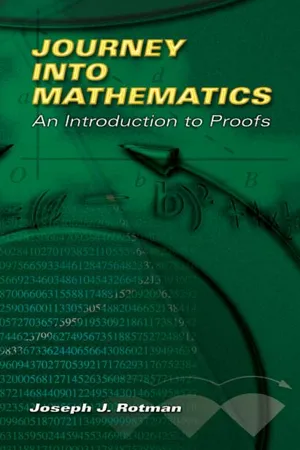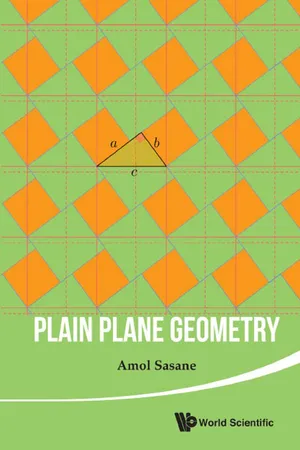Mathematics
Sector of a Circle
A sector of a circle is a region bounded by two radii and the corresponding arc of the circle. It is a portion of the circle's area and is defined by its central angle, which determines the size of the sector. The area of a sector can be calculated using the formula A = (θ/360)πr², where θ is the central angle and r is the radius of the circle.
Written by Perlego with AI-assistance
Related key terms
3 Key excerpts on "Sector of a Circle"
- eBook - ePub
- Mark Ryan(Author)
- 2016(Publication Date)
- For Dummies(Publisher)
You can find the area of a segment. Not, of course, the area of a line segment (which has no area), but the area of a segment of a circle — a completely different sort of thing. A circle segment is a chunk of a circle surrounded by a chord and an arc. The other circle region you look at here is a sector — a piece of a circle surrounded by two radii and an arc. In this section, I show you how to find the area of each of these regions. So here are the definitions of the two regions (Figure 15-2 shows you both): Sector: A region bounded by two radii and an arc of a circle (plain English definition: the shape of a piece of pizza) Segment of a circle: A region bounded by a chord and an arc of a circle © John Wiley & Sons, Inc. FIGURE 15-2: A pizza-slice sector and a segment of a circle. Just as an arc is part of a circle’s circumference, a sector is part of a circle’s area; therefore, computing the area of a sector works like the arc-length formula in the preceding section. Area of a sector: The area of a sector (such as sector in Figure 15-2) is equal to the area of the circle () times the fraction of the circle represented by the sector: Use this formula to find the area of sector ACB from Figure 15-1 : Because is of, the area of sector ACB is of the area of the circle (just like the length of is of the circle’s circumference). Area of a segment: To compute the area of a segment like the one in Figure 15-2, just subtract the area of the triangle from the area of the sector (by the way, there’s no. technical way to name segments, but let’s call this one circle segment XZ): You know how to compute the area of a sector. To get the triangle’s area, you draw an altitude that goes from the circle’s center to the chord that makes up the triangle’s base. This altitude then becomes a leg of a right triangle whose hypotenuse is a radius of the circle. You finish with right-triangle ideas such as the Pythagorean Theorem - eBook - ePub
Journey into Mathematics
An Introduction to Proofs
- Joseph J. Rotman(Author)
- 2013(Publication Date)
- Dover Publications(Publisher)
Section 2 . It is impossible to compute the area of a circle on the diameter as the linear unit without trespassing upon the area outside of the circle to the extent of including one- fifth more area than is contained within the circle’s circumference, because the square on the diameter produces the side of a square which equals nine when the arc of ninety degrees equals eight. But taking the quadrant of the circle’s circumference for the linear unit, we fulfill the requirements of both quadrature and rectification of the circle’s circumference. Furthermore, it has revealed the ratio of the chord and arc of ninety degrees, which is as seven to eight, and also the ratio of the diagonal and one side of a square which is as ten to seven, disclosing the fourth important fact, that the ratio of the diameter and circumference is as five-fourths to four; and because of these facts and the further fact that the rule in present use fails to work both ways mathematically, it should be discarded as wholly wanting and misleading in its practical applications.Section 3. In further proof of the value of the author’s proposed contribution to education, and offered as a gift to the State of Indiana, is the fact of his solutions of the trisection of the angle, duplication of the cube and quadrature of the circle having been already accepted as contributions to science by the American Mathematical Monthly, the leading exponent of mathematical thought in this country. And be it remembered that these noted problems had been long since given up by scientific bodies as unsolvable mysteries and above man’s ability to comprehend.I display the bill for two reasons. The first, of course, is that one ought to see what one is criticizing. Second, we have here a prime example of how not to write mathematics. I will try to decipher the beginning of Section 1, but it is so poorly written that I can only guess at its meaning, if any. Given a circle of radius r , its “circular area” is πr 2 ; “quadrant” means one-fourth, so that a “quadrant of a circumference” seems to mean 2πr /4 = πr /2; “square” seems to mean the algebraic operation of multiplying a number by itself, whereas “equilateral rectangle” seems to mean the geometric figure we call a square (otherwise why not call it a square?). Thus, the text of the bill seems to say that πr 2 /(πr /2)2 = r 2 /r 2 ; that is, the bill wants to legislate the value of π to be 4 (it appears there are at least three other values for π - eBook - ePub
- Amol Sasane(Author)
- 2015(Publication Date)
- WSPC(Publisher)
concyclic .Definition 5.2 (Cyclic quadrilateral) . A quadrilateral is said to be cyclic if all of its vertices lie on a circle.Exercise 5.1. Show that if two circles intersect in two points, then the line through their centers is the perpendicular bisector of their common chord. Exercise 5.2. (Coming a full circle). Given an arc of a circle, provide a method for completing the circle.5.1Area and circumference of a circle
If we imagine a circle made of string, then we can cut the circular string at any point, stretch out the string along a line, and measure the length of the string. This length is called the circumference of the circle.Theorem 5.4 . The ratio of the circumference of any circle to its diameter is a constant, denoted by π .Proof . We will give an argument for this fact based on the following diagram showing concentric circles, of diameters d, d ′, each having an inscribed polygon with n sides.By the SAS Similarity Rule, the two triangles OAB and OA ′B ′ are similar, and thusButand as n becomes larger and larger, we expect the error in the above approximation to tend to 0, so thatSo the ratio of the circumference of a circle to its diameter is constant.Theorem 5.5 . The area of a circle of radius r is πr 2 .Proof . We inscribe a regular polygon with n sides inside the circle of radius r , and triangulate it by joining the center of the circle to the vertices of the polygon. By looking at the following picture, we will justify the expression πr 2 for the area of the circle.The area of the polygon is the area of the shaded parallelogram, and this is approximately the height (which differs from radius d /2 by a small amount) times the length of the base (which differs from half the circumference by a tiny amount). As n becomes larger and larger, we expect the errors above to go to 0, and so the area of the circle should beRemark 5.1 . (π /∈ℚ). Using tools from the subject of “calculus”, it can be shown that π
Learn about this page
Index pages curate the most relevant extracts from our library of academic textbooks. They’ve been created using an in-house natural language model (NLM), each adding context and meaning to key research topics.


